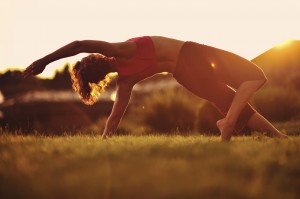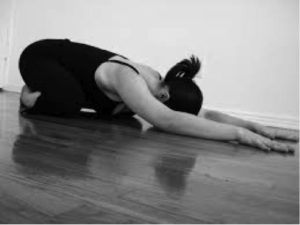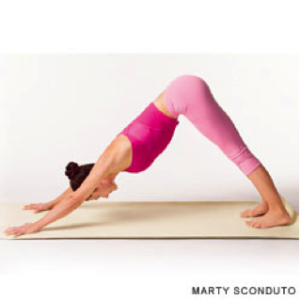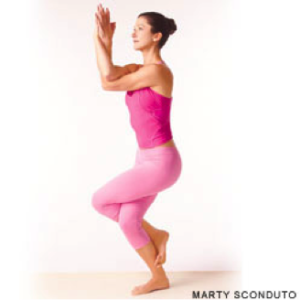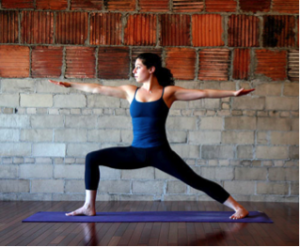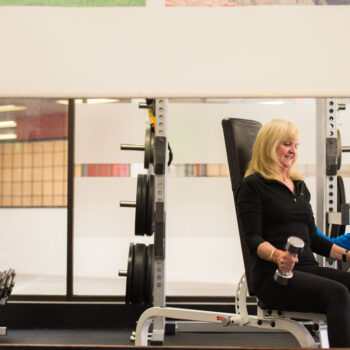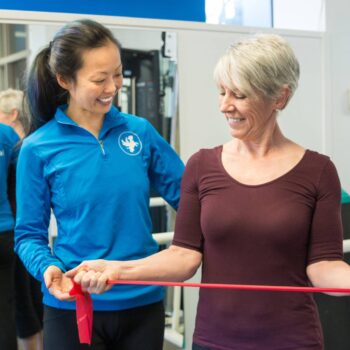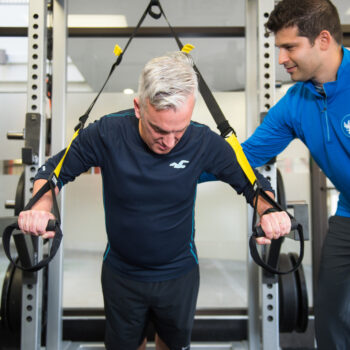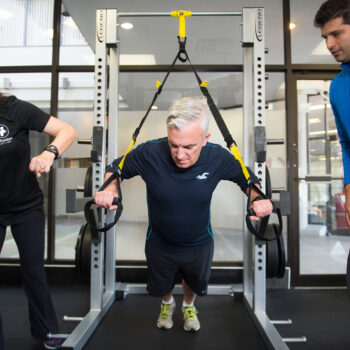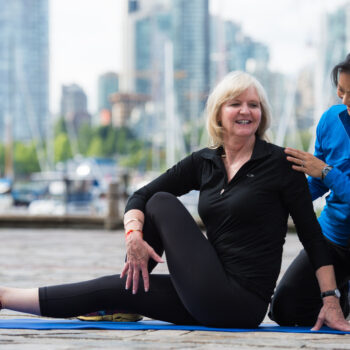What’s the buzz with yoga… And why is everyone doing it?
(plus – my top 5 fave yoga moves!)
by Melissa Garcia
Yoga has become an extremely popular leisure activity, and with it an increase on the awareness of the many mental and physical benefits that come through practicing it. Yoga has proven to improve overall fitness, aid in weight loss, be a great stress reliever, improve self-awareness, energy levels, flexibility and posture… the list goes on and on! Yoga differs from traditional weight lifting, instead of focusing on increasing resistance, but rather mastering your own body. Yoga poses recruit muscles that run along functional, anatomical lines, instead of muscles in isolation.
We live in a society where we are constantly multitasking, pushing ourselves to the limit and bringing work home with us. As a result, our stress response is in constant overdrive and stays on, even during the times it should not be on. Yoga brings about changes in the body’s sympathetic nervous system (the system that responds to stress) and prepares us for action, otherwise known as our ‘fight or flight response’. By practicing yoga regularly, one can reduce the levels of the stress-hormone, cortisol. Cortisol is released when we are stressed out, in a panic or anxious, but in excess it can be very harmful to the body if one is chronically stressed. Yoga also stimulates the body’s parasympathetic system as well, which is the system in charge of calming us down and restoring balance after a major stressor is over.
In addition to all these benefits, yoga has also been known to help individuals cope with mental stressors, and aid in the management of depression and bipolar disorder. Practicing yoga boosts the levels of “feel-good” brain chemicals like GABA, serotonin, and dopamine, which help you feel relaxed and happy. Imbalances in these neurotransmitters are one of the reasons as to why mental disorders are developed, and are the target of many mood medications such as antidepressants and anti-anxiety drugs.
I decided to give yoga a try about 2 years ago. I never thought yoga was for me; I always enjoyed fast paced sports like snowboarding, swimming and basketball, and could never see myself just sitting down for once and “wasting my time relaxing.” The thought seemed bizarre. After trying yoga, I realized my initial perception was totally wrong! Yoga is not just about meditating, stretching and practicing your breath. The truth is that there are so many different types of yoga ranging from “power”, to “flow”, to “core”, and “hot.” I have felt how my body has benefited from it, how it has increased my overall fitness, and what I treasure most is that one hour of practice is mine. The only time of the day when my mind is completely calm and relaxed, not worrying about what happened in the past or what’s to come in the future, but rather being there in the present.
Our 5 Fave Yoga moves – and why they are good for you
Child’s Pose or Balasana
This is a big favorite for many people! Nothing feels better than going into child’s pose after doing a few challenging yoga poses. There is something comforting about this position, as it is both calming and relaxing.
How to do child’s pose:
- Kneel down on your mat, spread your knees hip-width apart, touch your toes together and sit back on your heels.
- Maintaining this position, exhale while bending forward keeping you’re torso straight and stretch your hands out as far as you can in front of you.
- Let your shoulders relax and place your palms down.
- Hold this position for about 30 seconds to a minute
Anatomical Focus: lengthening the quadriceps and posterior line
Therapeutic Application: stress
Benefits:
- Relieves stress and fatigue while having calming effect on the brain
- Proven to relieve back and neck pain
- Gently releases tight hips, thighs, and ankles.
Downward Dog or Adho Mukha Svanasana
Nothing like that first downward dog in your practice, your muscles are just getting warmed up, your heals may not be touching the mat just yet… But it is incredible how much more flexible you become throughout the practice. You feel how each yoga pose opens your entire body.
How to do the downward dog:
- Start by placing your hands and knees shoulder-width apart on the mat. Straighten out your legs to a comfortable level while staying on the balls of your feet.
- Alternately shift the weight back and forth between your heels, bending your knees. Eventually settling your heels onto the mat. Lengthen your tailbone away from the back of your pelvis and press it lightly toward the pubis.
- In order to evenly distribute the weight between your hands and feet, make sure to press your hands firmly into the mat.
Anatomical Focus: Mid back and lower trapezius, overall arm strength, hamstrings and calf complex .
Therapeutic Application: sinusitis
Benefits:
- Helps relive stress and mild depression by calming the brain.
- Helps prevent osteoporosis.
- Helps relieve symptoms of menopause.
- Energized the body.
- Helps with insomnia, back pain and headaches.
- Improves digestion.
Eagle Pose or Garudasana
I remember the first time I did eagle pose; “focus on one point” keep your balance. As I kept practicing I noticed how significantly my balance had improved. This is what yoga is all about, becoming a master of your own body, knowing your limits and your body and pushing your body in ways you didn’t imagine possible.
How to do Eagle Pose:
- Stand tall in mountain pose with your feet hip width apart. With a slight bend in your knees, raise your left foot off the ground and balance on your right leg.
- Cross your left thigh over your right and let your left foot rest on your calf, with your toes pointing towards the floor.
- Lift your arms up straight in front of you. Bend your elbows and weave your right elbow into the space between your left forearm and bicep.
- Interweave your hands so that your palms are touching and bring your forearms so they are perpendicular to the floor.
- Hold for 15-30 seconds and gently unwind your body back into mountain pose.
- Repeat for opposite side.
Anatomical Focus: stability, ankles, calves, quadriceps, hips and shoulders.
Therapeutic Applications:
- Asthma
- Low backache
- Sciatica
Benefits
- Strengthens and stretches the ankles and calves
- Stretches the thighs, hips, shoulders, and upper back
- Improves concentration
- Improves balance
Warrior 2 or Virabhadrasana II
This is my personal favorite yoga pose. I don’t know why I like this pose so much; something about it makes me feel powerful, in charge, almost like I am Mulan. Like I am a warrior ready for battle…maybe you’ll like it too if that’s your sort of thing!
How to do Warrior 2:
- Bring your left leg to the front of the mat. Once you feel balanced reach your arms up and go into a high lunge.
- Once in the high lunge turn your back foot “outwards” 30 degrees. Lower your arms to shoulder level, making sure to keep them straight, with your palms facing downwards.
- Exhale and bend your left knee over the left ankle, so that the shin is perpendicular to the floor. Press both feet firmly into the mat.
- Press the tailbone slightly toward the pubis. Turn the head to the left and look out over the fingers.
- Stay for 30 seconds to 1 minute. Inhale to come up. Reverse the feet and repeat for the same length of time to the left.
Anatomical Focus: shoulders, quadriceps, glutes and hip stabilizers
Benefits
- Increases stamina.
- Strengthens and stretches the legs and ankles.
- Stimulates abdominal organs.
- Relieves backaches, especially during the second trimester of pregnancy.
Corpse pose or Savasana
Nothing feels better than ending your yoga practice with Savasana! After all of your hard work you get the next few minutes to relax, calm down, focus on your breath and really become connected with your body. There are rare times throughout our day where we are able to completely shut our mind off, well in this pose you literally become a “corpse”, and are able to enjoy the present moment without living in the past or present.
How to do Corpose Pose:
1) This is a relaxation pose, close your eyes. Place your body in a neutral position.
2) Start by lying down on your back, feet spread out as much as you like. Arms spread out by your sides with your palms facing up.
3) Make sure your shoulder blades rest evenly on the floor.
4) Soften your face, release your eyes to the back of the head and return to your normal breath.
5) Hold this position for 5 minutes.
Therapeutic Applications: stress
Benefits
- Calms the brain and helps relieve stress and mild depression
- Relaxes the body
- Reduces headache, fatigue, and insomnia
- Helps to lower blood pressure
Well there you have it folks, with only having discussed 5 out of the hundreds of different yoga poses, I strongly recommend giving yoga a try if you never have before. I already told you how my yoga journey changed my life, let it do the same for you!
Sign up now to Le Physique’s Beginner Yoga Workshop on March 15th to learn more about yoga! For more information or to register online, call us at 604-873-2255.


